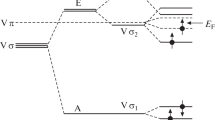Abstract
The era of the development of fundamentally new materials began with the discovery of graphene. Their unique properties already allow us to create many useful products in electronics, biomedicine, and other high-tech industries. However, the study of graphene and its derivatives is continuing. The mechanism of the formation of the graphene lattice and the state parameters of its individual atoms are still not fully understood. The reason for this is the fact that graphene itself cannot be obtained without laying carbon atoms on a surface with certain properties. However, in this case, the properties of graphene are substantially obscured by the properties of the surface itself. This study is devoted to the creation of a graphene model in the form of a lattice of hydrogen-like carbon atoms. In this case, we use a modification of the Brandt–Kitagawa approach with shielded ions that we proposed earlier. In the cold lattice approximation, this model assumes that the three valence atoms oriented along the bond lines belong to the ion shield. And only one valence electron determines the ground state of the lattice atom and the inhomogeneous angular distribution of its field.


Similar content being viewed by others
REFERENCES
W. Brandt and M. Kitagawa, “Effective stopping-power charges of swift ions in condensed matter,” Phys. Rev. B 25 (9), 5631–5637 (1982).
B. G. Freinkman, “Pseudopotential carbon atom model in graphene lattice,” Mat. Model. 27 (7), 122–128 (2015).
B. Freinkman, S. Polyakov, and I. Tolstov, “A variational solution of the Schrödinger equations in an inhomogeneous Coulomb field,” Int. Sci. J. Math. Model. 1 (3), 131–133 (2017). https://stumejournals.com/journals/mm/2017/3/131
I. Tolstov, B. Freinkman, and S. Polyakov, “A variational solution of the Schrödinger equation in an inhomogeneous central field,” EPJ Web Conf. 173, 03022 (2018). https://doi.org/10.1051/epjconf/201817303022
B. Freinkman, S. Polyakov, and I. Tolstov, “The variational solution of the Schrödinger equation for a hydrogen-like carbon atom in a graphene lattice,” in International Conference “Mathematical Modeling and Computational Physics” (MMCP 2019), Book of Abstracts (Stará Lesná, High Tatra Mountains, Slovakia, July 1–5, 2019), pp. 60–61.
V. A. Fok, Elements of Quantum Mechanics (URSS, Moscow, 2013) [in Russian].
P. Gambosh, Statistical Theory of the Atom and Its Application (Inostr. Lit., Moscow, 1951) [in Russian]; translated from: P. Gombás, Die Statistische Theorie des Atoms und Ihre Anwendungen (Springer, Wien, 1949) [in German].
J. D. Jackson, Classical Electrodynamics, 3rd ed. (Wiley, New York, 1999).
A.V. Eletskii, “Carbon nanotube-based electron field emitters,” Phys.-Usp. 53 (9), 863–892 (2010).
Funding
This study was supported by the Russian Foundation for Basic Research, project 20-07-00790-a.
Author information
Authors and Affiliations
Corresponding author
Rights and permissions
About this article
Cite this article
Freinkman, B.G. Self-Consistent Calculation of the Ground State of a Hydrogen-Like Carbon Atom in a Graphene Lattice. Math Models Comput Simul 13, 286–292 (2021). https://doi.org/10.1134/S2070048221020071
Received:
Revised:
Accepted:
Published:
Issue Date:
DOI: https://doi.org/10.1134/S2070048221020071




